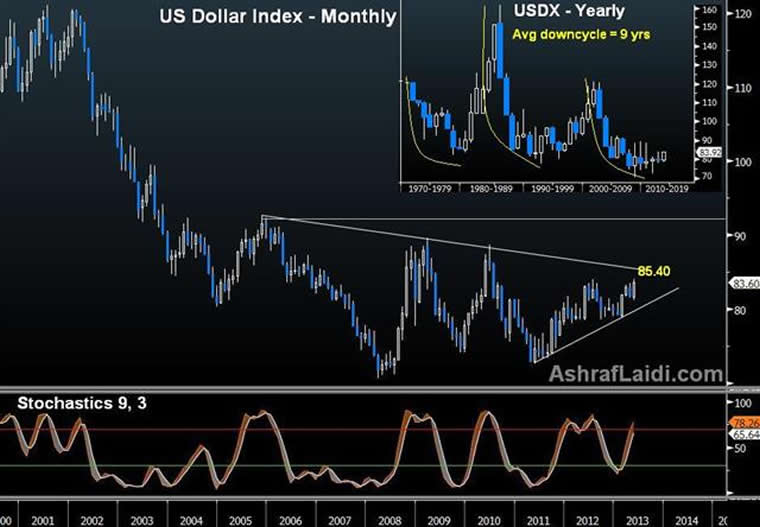US Dollar Ends Another 9 Year Down Cycle
Currencies / US Dollar May 17, 2013 - 08:55 PM GMTBy: Ashraf_Laidi
 Recent rallies in Non-USD currencies resulting from poor US data have not lasted long. And those rallies resulting from strong US figures via the indirect effect of rallying equities (risk-on) have not lasted either. Broadening pro-USD sentiment may stay for longer than we had thought as the US dollar index has exited from another 9-year down cycle.
Recent rallies in Non-USD currencies resulting from poor US data have not lasted long. And those rallies resulting from strong US figures via the indirect effect of rallying equities (risk-on) have not lasted either. Broadening pro-USD sentiment may stay for longer than we had thought as the US dollar index has exited from another 9-year down cycle.
The greenback has primarily been boosted by traders' realization that the Federal Reserve is the central bank most likely to precede its global peers in reducing its asset purchases program, regardless of whether it ends up not maintaining or increasing the program altogether. What matters in currencies are relative expectations, and at the present juncture, the Fed is the most likely to signal a gradual tapering of asset purchases, than other major central banks—even if such tapering isn't expected to take place until next year.
The case of the Bank of Japan is well known. Aiming to double monetary base from ¥135 trillion to ¥270 trillion within 2 years; raising the average maturity of Japanese Government Bonds to 7 years from 3 years—all via a monthly expansion of its balance sheet to the tune of 1.1% of GDP—compared to 0.5% of GDP by the Fed. And if that were not enough to drag down the currency, BoJ governor Kuroda is immensely experienced with verbally guiding the currency after his days 4-year stint at the MoF's International Affairs division.
The European Central Bank's avoidance of quantitative easing had been partly the result of improving market metrics relieving the stress off peripheral bond yields. Spain was spared the sacrifice of imposing deeper austerity policies as a condition to get more ECB bailout after its 10-year bond yields tumbled 50% off their July highs. With market metrics in better shape, the ECB is now occupied with deepening recessions throughout the bloc; 6th consecutive quarterly GDP contractions in the Eurozone, 7 straight contractions in Italy and the second quarterly decline in France. Chatter of negative ECB interest rates may end u being just than mere talk or currency jawboning. The euro is increasingly seen as a selling of the bounce rather than buying the dip.
The Bank of England has not added to its £375 bn asset purchase in nearly a year. The BoE has already raised questions about its own credibility after failing to bring inflation towards the 2.0% target for the past 40 months. Such failure had been highlighted by the fact that GDP growth posted 4 quarterly contractions during the 40-month period. This implies that upcoming BoE governor Mark Carney will do away with the 10-year practice of targeting EU-harmonized CPI of 2.0%, in order to focus on the job of more aggressive stimulus policy. And thus, markets anticipate at least more of the same in the way of quantitative easing, at the expense of sterling.
Commodity currencies are already being hit by the comprehensive damage in the commodity complex damage (Nat Gas is the only commodity up in double digits this year, while most metals and iron are down double digits with the exception of palladium). The Reserve Bank of Australia cut interest rates to 53 year lows, while the Reserve Bank of New Zealand resorted to admitting that it sold its own currency. This leaves the Bank of Canada as the exception in avoiding asset purchases, so far. But this month's appointment of the head of Canada's export agency at the helm of the Bank of Canada means that Canadian exporters will finally find an ally at the central bank. Stephen Poloz is likely to be more attentive to the needs of exporters via capping the Canadian dollar, which was not the case with Mark Carney. And as anecdotal evidence of swelling Canadian household debt becomes a legitimate banking concern, the combination of weak commodities and questionable loans quality is not conducive to a tight monetary policy.
The US dollar index may well be pressured by continued policy easing, but the role of relative expectations across G7 policy accommodation, US energy savings and asset market channels suggest that upside is the logical route and 88.0 on the USD index to finally be tested after a 3–year absence.
For tradable ideas on FX, gold, silver, oil & equity indices get your free 1-week trial to our Premium Intermarket Insights here
For more frequent FX & Commodity calls & analysis, follow me on Twitter Twitter.com/alaidi
By Ashraf Laidi
AshrafLaidi.com
Ashraf Laidi CEO of Intermarket Strategy and is the author of "Currency Trading and Intermarket Analysis: How to Profit from the Shifting Currents in Global Markets" Wiley Trading.
This publication is intended to be used for information purposes only and does not constitute investment advice.
Copyright © 2013 Ashraf Laidi
Ashraf Laidi Archive |
© 2005-2022 http://www.MarketOracle.co.uk - The Market Oracle is a FREE Daily Financial Markets Analysis & Forecasting online publication.



